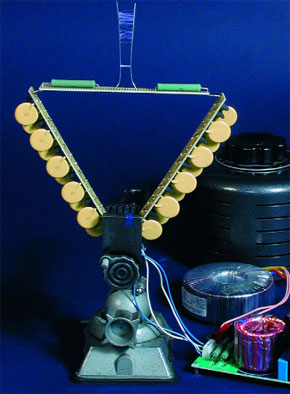Sparks ‘n Arcs
Experimenting with a Jacob’s Ladder

If you search the Internet for things related to high voltage, you quickly encounter terms such as ‘Tesla coil’ and ‘Jacob’s Ladder’. In its original form as invented by Nikola Tesla, a Tesla coil is an air-coupled transformer that works entirely on the principle of resonance and can easily generate potentials of several hundred thousand volts or even a few million volts. At such voltages, electric arcs jump randomly to surrounding objects, and we do not regard that type of experimenting as something that can be responsibly suggested as an example.
This is a MEMBER ONLY article. You need a subscription to read this article.
- Unlimited access to online Member Only articles
- 3 new editions Elektor Magazine (digital)
- More than 5000 Gerber files
- 20% member discount on e-books (at elektor.com)
- 10% member discount on Products (at elektor.com)
Available from €5.33 per month.
What is Members Only
Elektor is committed to providing high-quality content on electronics, catering to tens of thousands of paying members. As part of this commitment, Elektor has launched Premium, an initiative that offers exclusive online articles to members sometimes even before they appear in the magazine.
Every day, members can access in-depth articles that showcase the best of Elektor's premium content.
This initiative aims to reward members with early access. Once logged in, members can easily enjoy this exclusive content and engage in discussions about featured projects. While Premium adds to the existing resources available, Elektor will continue to provide a wealth of free information.
Join the Elektor community today to take advantage of Premium and other benefits!
Materials
Gerber file
CAM/CAD data for the PCB referred to in this article is available as a Gerber file. Elektor GREEN and GOLD members can exclusively download these files for free as part of their membership. Gerber files allow a PCB to be produced on an appropriate device available locally, or through an online PCB manufacturing service.
Elektor recommends the Elektor PCB Service service from its business partner Eurocircuits or AISLER as the best services for its own prototypes and volume production.
The use of our Gerber files is provided under a modified Creative Commons license. Creative Commons offers authors, scientists, educators and other creatives the freedom to handle their copyright in a more free way without losing their ownership.
Component list
Resistors:
R1 = 12k
R2,R4 = 12
R3,R5 = 33
R6 = 47 5W
R7,R8 = 330 10W
R9 = 6k8
R10 = 470 5W
P1 = 25k preset
Capacitors:
C1 = 150pF
C2,C4 = 10µF 63V radial
C3,C5 = 100nF ceramic
C6 = 100µF 25V radial
C7 = 1nF 400V MKT
C8 = 4µF7 100V MKT, lead pitch 27.5mm
C9 = 100nF 100V MKT
C10,C11 = 1000µF 100V radial, max. diameter 18mm
C12-C15 = 47nF 250V MKT
Inductor:
L1 = 10µH
Semiconductors:
D1,D2 = BY448
D3 = zener diode 10V 1.3W
D4 = zener diode 15V 1.3W
D5 = LED, low-current
D6 = 1N4004
D7-D10 = BY329-1000
T1,T3 = BC337
T2,T4 = BC327
T5,T6 = IRF640 or IRFB260N
IC1 = 4047
IC2 = 78L09
Miscellaneous:
K1-K4 = 2-way PCB terminal block, lead pitch 5mm
K5,K6 = -way PCB terminal block, lead pitch 7.5mm
TR1 = 2 x core B64290-L82-X830 (N30, 50 x 20 mm)*, e.g.. Epcos (Schuricht cat. no.: 330603); 2 x 12 turns. 0.8mm ECW primary (approx. 2 times 1.5m); 2 x 75 turns. 0.5mm ECW secondary (approx. 2 times 8m) F1 = fuse 5A/T (slow) with PCB mount holder
F2 = fuse 1A/T (slow) with PCB mount holder
2 x heatsink type SK129 63,5 STS (Fischer/Dau Components) (63.5mm high, 4.5K/W)
Mains transformer, secondary 2 x 30V @ 225VA, e.g. Amplimo/Jaytee # 68017
PCB, ref. 050192-1 from The PCBShop
Cascade board
Capacitors:
C1-C20 = 5600pF 2000V, Panasonic (High Voltage Disk Capacitor (Y5P) ECK3D562KBP), Digi-Key # P9574-ND
Semiconductors:
D1-D20 = DSA 1-18D (1800 V/7 A) IXYS, Digi-Key # DSA1-18D-ND
Miscellaneous:
PCB, ref. 050192-2, from The PCBShop



Discussion (0 comments)